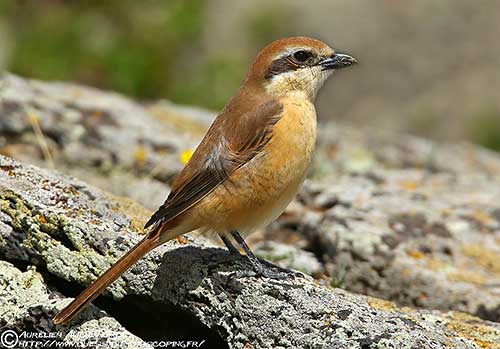
Fr: Pie-grièche brune
Ang: Brown Shrike
All: Braunwürger
Esp: Alcaudón Pardo
Ita: Averla bruna
Nd: Bruine Klauwier
Sd: brun törnskata
Photographers:
Aurélien Audevard
OUESSANT DIGISCOPING
Jean-Claude Jamoulle
A la rencontre des Oiseaux
Ingo Waschkies
Bird Photography
Text by Nicole Bouglouan
Sources:
HANDBOOK OF THE BIRDS OF THE WORLD Vol 13 by Josep del Hoyo-Andrew Elliot-Jordi Sargatal - Lynx Edicions – ISBN: 9788496553453
A Field Guide to the Birds of South-East Asia by Craig Robson. New Holland Publishers. ISBN: 9781780090498
THE HANDBOOK OF BIRD IDENTIFICATION FOR EUROPE AND THE WESTERN PALEARCTIC by Mark Beaman, Steve Madge - C.Helm - ISBN: 0713639601
Wikipedia, the free encyclopaedia
What Bird-The ultimate Bird Guide (Mitchell Waite)
THE AVIANWEB - Beauty of Birds (Sibylle Faye)
Brown Shrike
Lanius cristatus
Passeriformes Order – Laniidae Family
INTRODUCTION:
The Brown Shrike is a small, migratory shrike, often seen perched in upright stance. This is a very typical shrike that hunts from perches and impales prey on horny branches.
This species breeds in central and eastern Asia, and spends the winter in India, SE Asia and Indonesia. It frequents open country with bushes and scattered trees.
The Brown Shrike has four subspecies that differ in plumage pattern and coloration.
This species is not globally threatened, although its population is declining.
DESCRIPTION OF THE BIRD:
Biometrics:
Length: 17-20 cm
Weight: M: 27-34 gr – F: 28-37 gr
The Brown Shrike adult male of nominate race has rufous-brown crown and nape and slightly duller upperparts, except the rump and the uppertail-coverts that are slightly brighter. The upperwing is mostly dark brown with wing-coverts and inner flight-feathers edged whitish. The tail is dull rufous, with paler edges and tips on outer rectrices.
The underparts are whitish with pale rufous tinge, except on the white chin and throat. The undertail-coverts are pale brownish-grey.
On the head, crown and nape are rufous-brown. We can see a conspicuous black facial mask extending from lores through the eye to rear ear-coverts. There is a broad white supercilium. The lower forehead is creamy-white.
The hooked bill is black. The eyes are brown. Legs and feet are blackish.

The female resembles male but usually, she has buffy-white supercilium and the black mask is less distinct on lores. On the underparts, sides of breast and flanks are finely vermiculated.
The non-breeding adults have often a duller bill with pinkish base.
The juvenile has duller and less conspicuous supercilium, and brown, less extensive mask. Crown and upperparts are rufous with heavy grey-brown barring. The upperwing is brown with buffy-edged wing-coverts, secondaries and tertials.
The throat is whitish whereas cheeks and underparts are mostly buff with dense dark vermiculations. Centre of belly and vent are uniformly coloured.
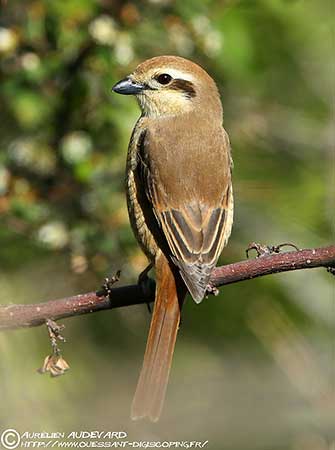
SUBSPECIES AND RANGE:
The Brown Shrike has four subspecies.
L.c. cristatus (described above) breeds in C and E Siberia, S to N Mongolia, L. Baikal area, N Sakhalin and W Kamchatka. It winters in C and S India, Sri Lanka, Bangladesh, Myanmar coastal area and Malay Peninsula.
L.c. confusus breeds in E Mongolia, SE Russia (SE Transbaikalia E to Amurland and Ussuriland) and Manchuria. It winters in S Malay Peninsula and Sumatra.
This race resembles nominate but the upperparts are paler and greyer in male, and the pale forehead is more extended. The female has pale rufous upperparts.
L.c. superciliosus breeds in S Sakhalin Island, S Kuril Island and N and C Japan. It winters on coastal S China, Hainan, NE and E Indochina, Sumatra, Java and W Lesser Sundaes.
This one is brighter than other races. The male has wider white band on forehead and broad white supercilium contrasting with the more extended black mask (from bill to near nape). Crown, nape and upperparts are bright rufous, with rufous wing edgings and sometimes a small white patch at primary bases. The underparts are more orange-tinged. The female is duller with less patterned plumage and paler, slightly vermiculated flanks.
L.c. lucionensis breeds in E China, Korea and S Japan. It winters mainly on coastal SE China, Taiwan, Philippines, N Borneo and N Sulawesi.
This race is much greyer than others. The supercilium is narrower. The male has pale grey crown and nape, brownish-grey upperparts, except rump and uppertail-coverts which are dark brown. Belly and flanks to undertail-coverts are buff. The female is paler than male with blackish-brown wash and less distinct supercilium.
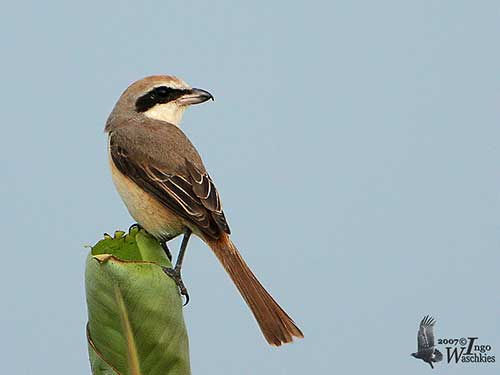
HABITAT:
The Brown Shrike breeds at woodland edges (deciduous, mixed or coniferous), and in bushy areas, thickets, groves and secondary growths in open country. It frequents mainly lowlands but it can be seen up to 2,000 metres of elevation.
During winter, it frequents the edges of cultivated areas, bushy areas and gardens.
CALLS AND SONGS: SOUNDS BY XENO-CANTO
The Brown Shrike is usually silent away from the breeding grounds. During the breeding season, it often utters a high-pitched squawking. The alarm call is a harsh “chak-ak-ak-ak-ak”.
The song is a rich, varied chattering, a repeated trilling “kichi-kichi-kichi” and/or “gey-gey-gey” while moving around treetops. The male often imitates songs and calls of other bird species.
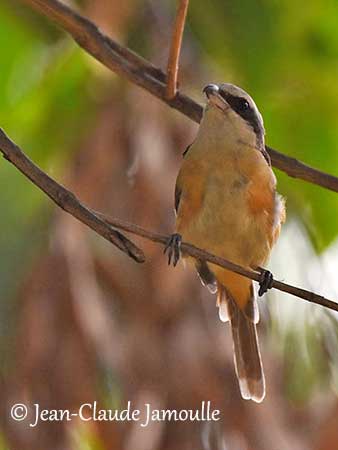
BEHAVIOUR IN THE WILD:
The Brown Shrike feeds primarily on insects such as Orthoptera and Coleopterans, other arthropods and spiders. It also takes small vertebrates such as small mammals, lizards, amphibians and small passerine birds, adults and nestlings.
It hunts from low perches, swooping or sallying for prey, but most prey are caught on the ground. Like all shrikes, it impales its prey on thorny branches, and it often caches food items. It usually disgorges pellets from an elevated perch.
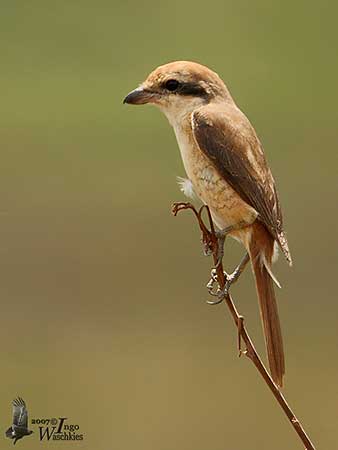
At the beginning of the breeding season, the male pursues the female in flight while singing. They are monogamous. During the fertile period of the female, the male is usually aggressive towards other males. It performs some displays, and mimics the action of impaling a prey. Then, it feeds the female and performs a kind of bowing dance. When the female is ready to copulate, she accepts the food and while holding the prey in the bill, she lowers the upper body.
They are territorial during the breeding season, and the perch sites are important for this behaviour. In S Taiwan, the migratory Brown Shrikes choose and use perches in foraging behaviour and interactions between them. They often favour protruding branches on a side of a tree canopy, making easier for the birds to detect prey on the ground while keeping an eye open for raptors.
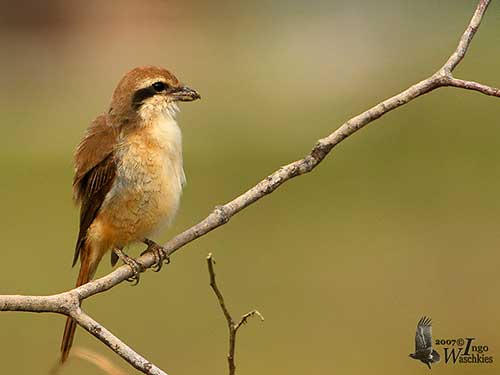
During migration, the Brown Shrike rests a lot between hunting bouts. Interactions often occur with small groups of migrating shrikes that land in an area before heading out to sea, probably towards the Philippines. In Taiwan, the Brown Shrike is known for maintaining feeding territories while on migration, and for defending them.
Only the races cristatus, confusus and superciliosus are migratory. However, the race lucionensis is only partially migratory, and appears to be resident in S Korea and E China, although most of populations migrate to non-breeding areas.
The Brown Shrike has relatively straight, swift flight with rapid wingbeats. From a study of migrant Brown Shrike in Malay Peninsula, this species migrates by night and on broad front. They descend to the ground during the day. They depend on fat and muscle reserves for migrating, indicating that they do not depend only on prey caught along their route.
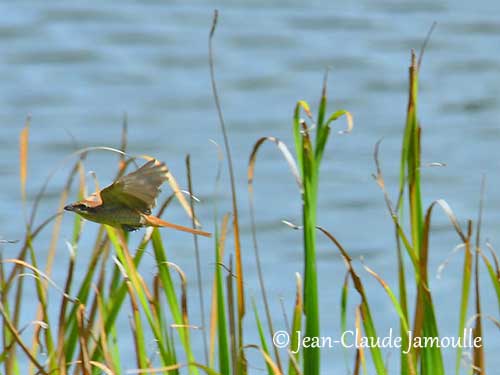
REPRODUCTION OF THIS SPECIES:
The breeding season varies according to the range, but it usually takes place in spring, with the laying in May/June. They produce a single brood per season. However, the female lays a replacement clutch if the first is lost before the chicks hatch.
Both adults build the nest but the female does most of the work during about one week. It is an open cup-shaped structure made with twigs, grass, stalks, rootlets, dry leaves and moss. The inner cup is lined with softer grass and animal hair.
The nest materials may vary depending on the range. In S Ussuriland, the birds use mainly bark fibres for the outer wall and thin dry grasses inside.
The nest is placed in tree or small bush, between 6 and 9 metres above the ground. But the races cristatus and confusus place it lower, below 3 metres, and sometimes on the ground, hidden among grasses or leaves.
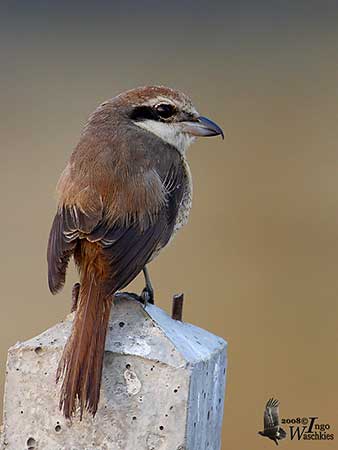
The female usually lays 4-6 reddish-white to greenish or buffish eggs with darker spots. She incubates alone during 12-14 days, and she is fed on nest by the male during this period. The chicks are fed by both parents, and they remain on the nest during 14-15 days. However, they remain in the vicinity of the nest for at least two weeks after fledging.
The Brown Shrike’s nest is often parasitized by Cuckoos.
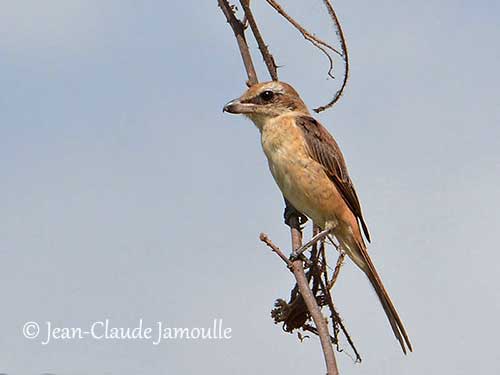
PROTECTION / THREATS / STATUS:
The Brown Shrike is not globally threatened and there is little information on population levels. No information on status of races cristatus and confusus. The race superciliosus has declined drastically in Japan. The status of the race lucionencis in Japan is uncertain.
This species occurs in several protected areas through the non-breeding range, and the Brown Shrike is currently evaluated as Least Concern.
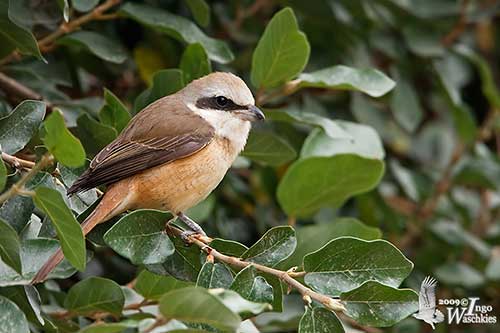
L.c. lucionensis
Male
L.c. lucionensis
L.c. lucionensis
Immature